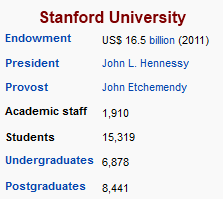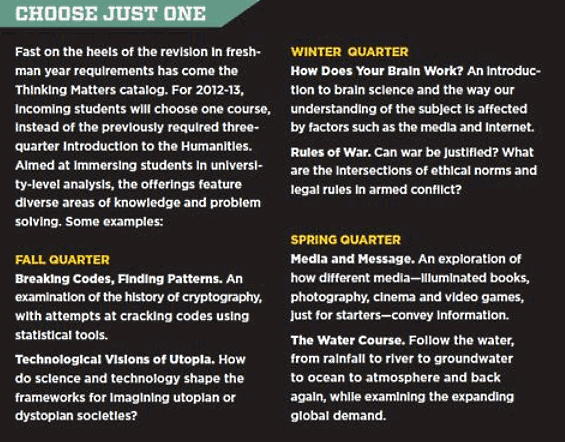|
News & Views item - August 2012 |
![]() Should It Be Dubbed the Stanford Model? (August 7, 2012)
Should It Be Dubbed the Stanford Model? (August 7, 2012)
 Electrical
Engineer, John Hennessy, has been president of Stanford University since October
2000. In his "President's Column" for the university's midyear issue of the
magazine he asks the rhetorical question "What do we want our [undergraduate]
students to gain from their time [at Stanford]? And follows by noting that the
Study of Undergraduate Education at Stanford (SUES) was begun in January 2010 --
seventeen years after the previous examination of the undergraduate curriculum.
Electrical
Engineer, John Hennessy, has been president of Stanford University since October
2000. In his "President's Column" for the university's midyear issue of the
magazine he asks the rhetorical question "What do we want our [undergraduate]
students to gain from their time [at Stanford]? And follows by noting that the
Study of Undergraduate Education at Stanford (SUES) was begun in January 2010 --
seventeen years after the previous examination of the undergraduate curriculum.
The 17-member SUES committee brought down its 130-page report containing 55 recommendations in January of this year. Overall the committee finds that in order to meld breadth and depth of knowledge, which it considers to be "vital in this century" the undergraduate program should retain major subjects to provide depth while "new, non-disciplinary breadth requirements" need to be added.
 As
Professor Hennessy describes it: "Innovative 'Ways of Thinking, Ways of Doing'
courses were proposed to develop essential skills and capacities, such as
aesthetic and interpretive inquiry, social inquiry, scientific analysis, formal
and quantitative reasoning, moral and ethical reasoning, and creative
expression." Among universal undergraduate prerequisites for graduation that
will be retained are a foreign language requirement and a two-quarter sequence
on writing and rhetoric". In addition: "All freshmen will take a 'Thinking
Matters' course, organized around questions or problems, that will help them
make the transition to university-level thinking, approach complex topics from
multiple disciplinary viewpoints and develop as critical thinkers" as well as a
requirement for "creative expression which may be filled in a variety of ways,
each of which helps students develop the capacity to create, and I believe it
will be greatly enhanced by Stanford's ongoing investment in the arts and
fostering creativity."
As
Professor Hennessy describes it: "Innovative 'Ways of Thinking, Ways of Doing'
courses were proposed to develop essential skills and capacities, such as
aesthetic and interpretive inquiry, social inquiry, scientific analysis, formal
and quantitative reasoning, moral and ethical reasoning, and creative
expression." Among universal undergraduate prerequisites for graduation that
will be retained are a foreign language requirement and a two-quarter sequence
on writing and rhetoric". In addition: "All freshmen will take a 'Thinking
Matters' course, organized around questions or problems, that will help them
make the transition to university-level thinking, approach complex topics from
multiple disciplinary viewpoints and develop as critical thinkers" as well as a
requirement for "creative expression which may be filled in a variety of ways,
each of which helps students develop the capacity to create, and I believe it
will be greatly enhanced by Stanford's ongoing investment in the arts and
fostering creativity."
Finally, in the president's view "perhaps the most distinctive aspect of the curriculum arising from the review of 1993-94" -- the Commission on Undergraduate Education -- are the non-compulsory Freshman seminars, small group courses, giving first year students opportunities to work closely with faculty. "The Faculty Senate voted to encourage but not require students to take a freshman seminar," because it was felt that to make them obligatory "could destroy the 'magic' that occurs when faculty and students are driven solely by common interest in a topic."
While the overall goal of the Melbourne and Stanford Models are not dissimilar there are fundamental differences in their approach to undergraduate tertiary education. Whether or not Stanford's approach will prove successful remains to be seen -- as President Hennessy writes: "At a time when many institutions are abandoning a commitment to a liberal education, Stanford's faculty believes that our future graduates will be best served by being broadly educated," while retaining the drive toward a major discipline.